
14 Oct TIO FRANCE: RESTAURANT/HOTEL ITHURRIA & ESPELETTE
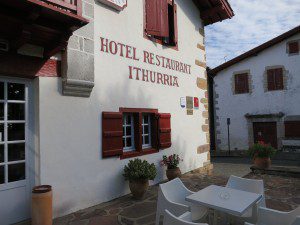 In Basque country, art is mostly found on plates.
In Basque country, art is mostly found on plates.
Several years ago we toured the Spanish Basque region. We went for Bilbao. We stayed for the people – and the food. Food is at the heart of Basque culture, where neighboring communities regularly share the best produce from the land and the water. It would not be stretching the point to say “Basque” rhymes with “locovore.”
San Sebastian, for one primo example, is home to Arzak, widely considered one of the finest restaurants in the world and generally an impossible ticket without reservations months in advance. But we got lucky. Our hotel in Hondarribia used our press credentials as a wedge to wangle a reservation for lunch. Lunch turned out to be a four-hour, eight-course feast for the eyes and palate we talk about to this day. But we never imagined there would be a second helping, just as good.
But we were wrong. We got lucky. Again.
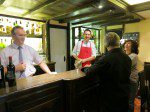 Last week, we visited the French Basque region, where our host at Hotel La Deviniere in Saint-Jean-De-Luz, Bernard Carrere, also happens to be one of the founders and heads of the Slow Food (read farm to table) movement in southwest of the country and publisher of the Guide Hubert, all about regional restaurants and wines for all tastes and pocketbooks. One afternoon, Bernard decided to take us to one of his very favorite eateries.
Last week, we visited the French Basque region, where our host at Hotel La Deviniere in Saint-Jean-De-Luz, Bernard Carrere, also happens to be one of the founders and heads of the Slow Food (read farm to table) movement in southwest of the country and publisher of the Guide Hubert, all about regional restaurants and wines for all tastes and pocketbooks. One afternoon, Bernard decided to take us to one of his very favorite eateries.
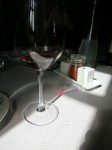 Ithurria is located in town of Ainhoa, ranked among the finest (i.e. “picturesque”) villages in all of France. The building that houses the restaurant and hotel dates back to 1657 and was once a staging post on the fabled medieval pilgrims’ route to Santiago de Compostela. Today people like us are making pilgrimages to the site for soul food of a whole other variety.
Ithurria is located in town of Ainhoa, ranked among the finest (i.e. “picturesque”) villages in all of France. The building that houses the restaurant and hotel dates back to 1657 and was once a staging post on the fabled medieval pilgrims’ route to Santiago de Compostela. Today people like us are making pilgrimages to the site for soul food of a whole other variety.
In 1962, Marie Louise and Emile Ithurria purchased the historic building (a registered monument) and related property from the Alaborda family. The couple was initially assisted by daughter Martichu and son-in-law Maurice, the chef, who established the reputation of the reincarnated structure (and today, is president of the Slow Food movement in the region). In 1990, the third generation of Ithurria began making their moves. Son Stephane claimed the front of the house as his turf; Xavier, the kitchen. The brothers took over the operation in 2007. Escorted by Bernard, when we arrived on site, mother, father and sons treated us like long lost family.
Ithurria’s menu is much simpler, less fanciful and less ambitious than Arzak’s flashy “carte,” but no less true to the Basque legacy of place makes the race.
Foodies, get ready for your taste buds to do a happy dance.
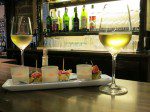 Xavier’s memorable feast began with amuse bouches of a pannacotta of celery and apple alongside a petite egg torte accented with sweet pimento and Bayonne ham. Both delicacies were served with a sweet white wine, Jurancon, aka, “the wine of the king and the king of the wine” (because legend has it that was the wine a newborn King Henry IV was given at birth).
Xavier’s memorable feast began with amuse bouches of a pannacotta of celery and apple alongside a petite egg torte accented with sweet pimento and Bayonne ham. Both delicacies were served with a sweet white wine, Jurancon, aka, “the wine of the king and the king of the wine” (because legend has it that was the wine a newborn King Henry IV was given at birth).
Entrees included a duck foie gras served with local figs and a galette (a kind of cake) fashioned from anchovies, pimentos, sea salt and olive oil.
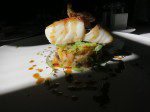 Main courses featured cabillaud (a cod dish) and a costilla de porc noir iberique (pork).
Main courses featured cabillaud (a cod dish) and a costilla de porc noir iberique (pork).
Desserts included a lighter-than-air chocolate soufflé – lighter than air means no calories, right? – and a honey meringue confection.
The wines, including a robust Saint Emilion, were courtesy of Bernard.
Ithurria, Rue Principale, Ainhoa, is open April – October. The restaurant brags one star from Michelin, but according to Bernard, that’s only because Xavier and Stephane are unwilling to jump through the hoops required to obtain a galaxy.
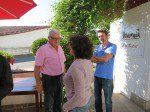 Sated and smiling following our repast, we toured the property, including Maurice’s weapon collection, vegetable gardens and chicken enclave, before heading out for our next stop, the town of Espelette.
Sated and smiling following our repast, we toured the property, including Maurice’s weapon collection, vegetable gardens and chicken enclave, before heading out for our next stop, the town of Espelette.
Espelette is (another) picture-postcard town featuring traditional Labourd houses. It was in Espelette we heard from the mayor, (another friend of Bernard’s, who led the tour) why Basque houses look the way they look.
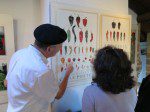 The houses are made of stone, but in ancient times peasants were taxed based on the number of stones used in construction. Clever Basques decided to cover their backs (and wallets) by covering the stone work with stucco. Now try and count. Why the stucco got painted white comes down to religion. On the days locals celebrated the holidays of saints, they purportedly draped the facades of their homes in white sheets. In the end everyone decided they liked the look, but grew tired of the extra laundry: white paint became a surrogate for white sheets. Paint for shutters and trim was originally from cattle blood, hence the standard reddish brown. (Green and blue shutters came later.)
The houses are made of stone, but in ancient times peasants were taxed based on the number of stones used in construction. Clever Basques decided to cover their backs (and wallets) by covering the stone work with stucco. Now try and count. Why the stucco got painted white comes down to religion. On the days locals celebrated the holidays of saints, they purportedly draped the facades of their homes in white sheets. In the end everyone decided they liked the look, but grew tired of the extra laundry: white paint became a surrogate for white sheets. Paint for shutters and trim was originally from cattle blood, hence the standard reddish brown. (Green and blue shutters came later.)
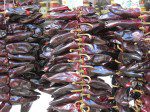 Espelette is the pimento capital of the region and local peppers, designated Appellation d’Origine Controlee, are hung out to dry on many of the houses and shops in the village every summer into the fall.
Espelette is the pimento capital of the region and local peppers, designated Appellation d’Origine Controlee, are hung out to dry on many of the houses and shops in the village every summer into the fall.
More about more to do in the region soon….


Ric
Posted at 03:37h, 15 OctoberSuz, I’m hungry just reading the description. And yes, lighter than air means no calories as long as you work out for an extra hour or so. By the way, how was the foie? You know California has now banned foie, and NY is threatening to do it as well. Safe trip home.
Jake from Hotel Primer
Posted at 19:34h, 23 OctoberMy wife and I ate here on the last night. We went for the a-la-carte menu and this was a tad pricey but great. We enjoyed the various amuse bouches [Sort of a mini gazpacho,a slice of local ham on walnut bread, and mackerel pate on Breton pancake] and the main courses we had chosen from the menu were all very good indeed. The service was attentive and managed to hit just the right balance between formality and friendliness.The restaurant is in a very attractive room with large old fireplace and furnished in a traditional style to echo the age of the building. This meal was a worthy and decadent splurge for us and ranks highly our ‘best meal ever’ list !
admin
Posted at 16:28h, 04 NovemberThx for your response. And where are you from? Did you travel far for your great meal?